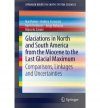About this book
Improved dating methods have increased our ability to more precisely determine the timing and durations of glaciations. Utilizing glacial and loess deposits, in Glaciations in North and South America from the Miocene to the Last Glacial Maximum, we have compared glaciations that occurred in North and South America in order to determine if events are synchronous or not, to explore forcing mechanisms, and to compare glaciations with cold periods of the Marine Oxygen Isotope stages and the loess/paleosol records of China.
Stratigraphic sections containing a variety of glacial deposits, some with interbedded volcanics, as well as loess deposits, were used in reconstructing the glacial history. The Late Pleistocene (Brunhes Chron) Last Glacial Maximum is recognized in mountain and continental areas of North America but only in the mountains of South America. Commonly our comparisons indicate roughly synchronous glaciations on the two continents, whereas other glaciations are more elusive and difficult to compare. Although our comparisons are at low resolutions, the results suggest that Milankovitch forcing is most likely the dominant trigger for hemispheric glaciation modified by local factors.
Contents
- Introduction and Previous Work
- The Glacial and Loess Record of Southern South America
- The Glacial Record of Northern South America
- The Glacial and Loess Record of North America
- Comparison of South and North American Glaciations
- Chinese Loess/Paleosol Record
Customer Reviews
Biography
Nat Rutter's research centers on paleoclimates and climate change during the Quaternary period. Special emphasis has been placed on loess-paleosol sequences in North Central China, Siberia and the Russian Plain. A major effort by his students has been on the Quaternary stratigraphy and environments of western and northern Canada. Other research includes the Quaternary stratigraphy of the Colombian Andes and the glacial geology of the Canadian Rocky Mountains.
Andrea Coronato is Professor of Physical Geography at the Universidad Nacional de la Patagonia San Juan Bosco in Ushaia, Tierra del Fuego, Argentina, and researcher of the Laboratorio de Cuaternario, Centro Austral de Investigaciones Cientificas (CADIC), Consejo Nacional de Investigaciones Cientificas y Tecnologicas (CONICET) at Ushaia, with emphasis on the physical geography, geomorphology, and paleoenvironments of Southern Patagonia and Tierra del Fuego. In the last years she has worked on the study of glacial, fluvial, and Aeolian geomorphology, Quaternary glaciations and the environmental impact of Canadian beavers on fluvial systems of Tierra del Fuego.
Jorge Rabassa is Professor of Geography at the Universidad Nacional de la Patagonia San Juan Bosco, Ushaia, Tierra del Fuego, Argentina, and researcher of the Laboratoria de Cuaternario, Centro Austral de Investigaciones Cientificas (CADIC), Consejo Nacional de Investigaciones Cientificas y Tecnologicas (CONICET) at Ushaia, working on late Cenozoic geology, geomorphology, and paleoenvironments. During the past years he has studied glacial geology and geomorphology of Southern Patagonia and Tierra del Fuego, Late Cenozoic glaciations, and the impact of global climate change on Patagonia glaciers. Jorge Rabassa is the editor of the book The Late Cenozoic of Patagonia and Tierra del Fuego, Vol. 11: Developments in Quaternary Science (2008).
Karin F. Helmens works for the Department of Physical Geography and Quaternary Geology of Stockholm University and is, among others, author of the book Neogene-Quaternary geology of the high plain of Bogota, Eastern Cordillera, Colombia: stratigraphy, paleoenviroments, and landscape evolution (1990).
Marcelo Aristides Zárate worka at the Instituo de Ciencias de la Tierra y Ambientales de La Pampa in Argentina. He is currently Investigador of CONICET and works for the FCEN-Universidad Nacional de La Pampa as Adjunct Professor. He has about 85 publications to his name.







































